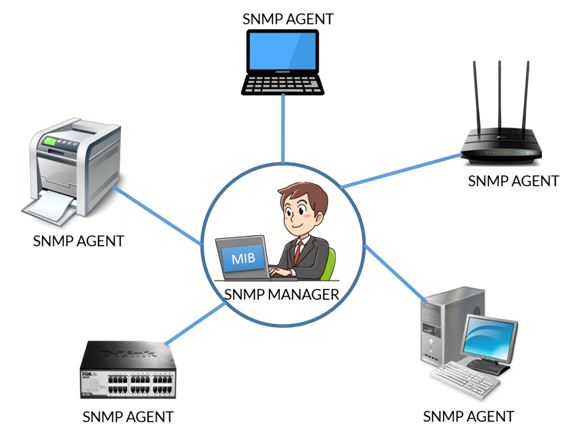Are you utilizing SNMP traps in the right way? When your IT infrastructure is overwhelming you with problems, being able to set your priorities straight can make all the diversity in the world. To have the choice of what you want and what you don’t want to be alerted about, can make you efficient and swift.
Contents
What does SNMP Trap mean?
An SNMP trap is a tool that enables devices on the connected network and sends the information to a particular management channel using an SNMP protocol. It generally involves two devices, and a remote device enabled for SNMP traps and one main collector, that is sometimes called an SNMP manager. An SNMP trap can be used to send urgent alerts, for example, perhaps when the machine is overheating. Trap messages are usually used to communicate between the two devices involved, “Agent” and “Manager.”Further, they are triggered when something is deemed important at the “Agent” level.
SNMP traps can be very beneficial. They are triggered instantly and do not wait for a request for a status report. On big networks, it becomes useful as a substitute for active SNMP and reduces network load. This is an incredibly fluid mechanism, as it can be used to configure devices to send exceptionally specific kinds of traps such as BGP, link status changes, HSRP, etc.
The Types of Devices that Use SNMP Traps
SNMP traps function differently on the newer devices as opposed to the older devices. On the other side, they react in a different way when faced with a problem. The latest gadgets are capable of simply sending an alert independently to the SNMP manager when faced with an issue. On the other hand, the older gadgets that cannot be equipped with SNMP, an SNMP RTU is employed to gather the alarms from numerous legacy devices. And then change those into SNMP traps, further transmitting them to the SNMP Manager.
Types of SNMP Traps
It is imperative to make the attributes amid the various versions of SNMP traps, such as v1, v2c,or v3. Each version has its own key benefits and disadvantages. The choice between them has to base on compatibility, rather than any outstanding merit. It is important to understand that SNMPv3 supports security encryptions, whereas setting up v1 is far simpler. Don’t forget that you may have to update the older versions. You may also download a translator that would help switch between the various SNMP versions.
Tips for using SNMP for Flawless Supervision:
Principles like understanding which types of traps are essential and which are not can help properly prioritize significant issues, and make effective use of SNMP traps.
You have to make a decision on whether or not you want to be alerted every single time a link is switched on or off. This becomes important when particular ports have been allocated as spare, or if aspecific VLAN that has been designated to visiting engineers.
Limitations of SNMP Traps:
The SNMP traps are asynchronous; that is, messages are transmitted only when an issue has to be reported. This functionality makes it difficult to automatically ensure a device is still online, unlike some other polled protocols, where you can receive periodic updates. Other different protocols have central masters that frequently ask every device for updates.
The SNMP trap is also unable to provide proof of reception of the Manager’s messages. However, the latest versions have the “inform” message feature, in which an SNMP ‘inform’ message is sent to be confirmed by the Manager. The message can be resent if the SNMP agent does not receive confirmation from the Manager on the reception of the message.
The Encoding of Alarms in Traps:
Alarms are encoded in SNMP traps in two ways, either by using what is known as granular traps, or configuring the trap to hold alarm data as payloads.
These types make use of unique OIDs to distinguish themselves from each other. This OID can be identified by the SNMP manager in a translation file known as the MIB or the management information base. This function means redundant information does not need to be sent. This scenario is because the granular traps can simply look up OIDs in the MIB and alarm data is not contained in the SNMP trap itself. Therefore, granular traps do not consume as much of the bandwidth.
Other than granular traps, SNMP also traps function using the same OID for all traps in the device. By doing this, they store alarm data within themselves as key-value pair configurations called “variable bindings.”For example, an SNMP trap may have distinct variable bindings matching each of the functions “severity,” “alarm description,” and “site name.” In this case, the SNMP manager has to analyze the data in every single trap separately.
Typical Solutions for Failing SNMP Traps
The SNMP trap may not work correctly if a trap name is missing, or if it did not correspond with service check or if port 162 is blocked. By inspecting the exceptions window in your network monitoring solution, you can precisely set the rules according to your priorities. This step will help identify the parts of information that are tracked when received from your computer. Traps will employ a variety of mechanisms like network equipment, Windows event logs, Linux OS, and others.
Key Takeaways:
So, traps can help and lend a hand to you for receiving alerts about key pieces. When you use them right, you gain the ability to make several informed and accurate decisions. Hence, take sufficient time to understand and master SNMP traps.
